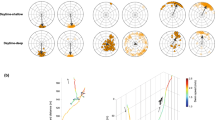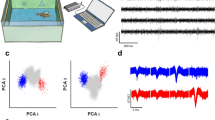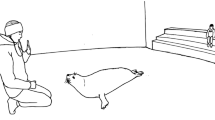Abstract
Memory and learning in invertebrates with decentralized nervous systems is poorly understood and sea urchins are no exception. Following up on previous studies of locomotory direction in sea urchins, the regular sea urchin, Hemicentrotus pulcherrimus was used to examine whether they have directionality and ‘memory’ of direction in locomotion. Experiments were conducted in 2011–2013 on urchins collected from the subtidal rocky area off the Aburatsubo coast, Kanagawa, Japan. The sea urchins locomoted mainly with their tube feet. Individuals retained their directional locomotion in two successive trials separated by a resting period. This implies memory of the original direction and is termed “directional memory”. This memory was retained when the resting period was 5 min but disappeared when the period was extended to 10 min. Such directional memory was also observed in cutaway preparations in which the aboral one-third of the test was removed along with the viscera. The radial nerves (RNs) were severed in cutaway preparations to study their roles in memory and activities of the tube feet. The speed of locomotion was proportional to the total length of the RNs. When all RNs were separated from the nerve ring, the preparation continued to attach firmly to the substrate. When all RNs but one were cut at the midpoint, preparations locomoted keeping the ambulacrum with the uncut, longest RN forward. When all RNs were cut at the midpoint, directional memory was observed without the interference of the longest RN. A model in which each ambulacrum assumes one of four modes (leading, trailing, attached, or retracted) with its tube feet being controlled and coordinated by the RN, and where mode switching is caused by the mechanical pull of other ambulacra and or via the RN–ring system accounts for these findings.










Similar content being viewed by others
References
Batschelet E (1981) Circular statistics in biology. Academic Press, New York
Cobb JLS (1970) The significance of the radial nerve cords in asteroids and echinoids. Z Zellforsch 108:457–474
Cobb JLS (1982) The anatomical basis of integratory mechanisms in echinoderms. In: Lawrence JM (ed) Proceedings of the int. echinoderm conf., A. A. Balkema, Rotterdam, pp 409–412
Cobb JLS (1987) Neurobiology of the echinodermata. In: Ali MA (ed) Nervous systems in invertebrates. Plenum, New York, pp 483–526
Cohen-Rengifo M, Moureaux C, Dubois P, Flammang P (2017) Attachment capacity of the sea urchin Paracentrotus lividus in a range of seawater velocities in relation to test morphology and tube foot mechanical properties. Mar Biol 164:79
Connolly DM, Desvignes T, Williamson JE (2017) Influence of body size on tube feet morphology and attachment capacity in the sea urchin Holopneustes purpurascens (Temnopleuridae). Mar Biol 164:223
Denny M (1999) Are there mechanical limits to size in wave-swept organisms? J Exp Biol 202:3463–3467
Domenici P, Gonzales-Calderon D, Ferrari RS (2003) Locomotor performance in the sea urchin Paracentrotus lividis. J Mar Biol Assoc UK 83:285–292
Flammang P (1996) Adhesion in echinoderms. Balkema, Rotterdam
Hochberg Y, Tamhane AC (2009) Multiple comparison procedures. Wiley, New York
Hyman LH (1955) The invertebrates: echinodermata, 4. Echinoidea. McGraw-Hill, New York
Kerkut GA (1953) The forces exerted by the tube feet of the starfish during locomotion. J Exp Biol 30:575–583
Kerkut GA (1954) The mechanisms of coordination of the starfish tube feet. Behavior 6:206–232
Lal SP, Yamada K, Endo S (2008) Emergent motion characteristics of a modular robot through genetic algorithm. Lect Notes Comput Sci 5227:225–234
Lawrence JM (1987) A functional biology of echinoderms. Croom Held, London
McClintock JB, Lawrence JM (1982) Photoresponse and associative learning in Luidia clathrata say (Ecinodermata: Asteroidea). Mar Behav Physiol 9:13–21
McCurley RS, Kier WM (1995) The functional morphology of starfish tube feet: the role of a crossed-fiber helical array in movement. Biol Bull 188:197–209
Romanes GJ, Ewart JC (1881) Observations on the locomotor system of Echinodermata. Philos Trans R Soc Lond 172:829–885
Smith JE (1945) The role of the nervous system in some activities of starfish. Biol Rev 20:29–43
Ullrich-Lüter EM, Dupont S, Arboleda E, Hausen H, Arnone MI (2011) Unique system of photoreceptors in sea urchin tube feet. Proc Natl Acad Sci 108:8367–8372
Yoshimura K, Motokawa T (2008) Bilateral symmetry and locomotion: do elliptical regular sea urchins proceed along their longer body? Mar Biol 154:911–918
Yoshimura K, Motokawa T (2010) Bilaterality in the regular sea urchin Anthocidaris crassispina is related to efficient defense not to efficient locomotion. Mar Biol 157:2475–2488
Yoshimura K, Iketani T, Motokawa T (2012) Do regular sea urchins show preference in which part of the body they orient forward in their walk? Mar Biol 159:959–965
Acknowledgements
We are grateful to the staff of Misaki Marine Biological Station for collecting H. pulcherrimus. We would like to express thanks to Mr. Y. Miwa for technical assistance. We would like to express thanks to Dr. O. Ellers of Bowdoin College for improvement of English description of our manuscript.
Funding
This research was supported by the Grant-in-Aid for Scientific Research from the Ministry of Education, Culture, Sports, Science and Technology, Japan to T. M. (No. 21570075).
Author information
Authors and Affiliations
Corresponding author
Ethics declarations
Conflict of interest
The authors declare they have no conflict of interest.
Ethical approval
All applicable international, national, and/or institutional guidelines for the care and use of animals were followed.
Additional information
Responsible Editor: J. Grassle.
Reviewed by J. B. McClintock and an undisclosed expert.
Rights and permissions
About this article
Cite this article
Yoshimura, K., Tsurimaki, H. & Motokawa, T. Memory of direction of locomotion in sea urchins: effects of nerves on direction and activity of tube feet. Mar Biol 165, 84 (2018). https://doi.org/10.1007/s00227-018-3342-y
Received:
Accepted:
Published:
DOI: https://doi.org/10.1007/s00227-018-3342-y




